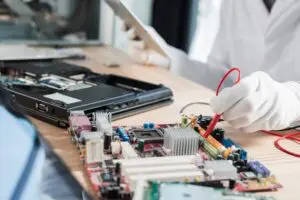You might think handling your own PCB assembly in-house is a smart way to cut costs. After all, it gives you control over production, eliminates some vendor coordination, and may seem to improve your overall efficiency. But what if that decision is actually eating away at your profitability and scalability without you realizing it?
It happens more often than you’d expect. In-house PCB assembly often hides its true cost beneath the surface because the expenses don’t show up on a single line item. Instead, they’re scattered across payroll, equipment depreciation, facility costs, and lost productivity.
If you’re still managing your own printed circuit board assembly process, it’s time to examine what this decision is really costing you and whether PCB assembly outsourcing might be a more profitable path forward.

(freepik/Freepik)
The Real Cost Behind Your Internal Assembly Operation
On paper, setting up in-house PCB assembly seems straightforward. You buy the equipment, hire some staff, and handle production yourself. It feels like a smart business decision that gives you control and cuts out the middleman.
The reality hits differently. Your assembly equipment needs regular maintenance and calibration. Your technicians require training every time new components or processes come up. Quality control becomes a constant challenge that demands attention and resources you didn’t plan for.
Then come the costs nobody talks about in the planning phase. Equipment breaks down and halts production. Assembly mistakes mean scrapped boards and wasted materials. Good technicians leave, and training replacements takes time and money. These hidden expenses can quietly eat away at the savings you expected from doing it yourself.
Lost Time and Stalled Innovation
As your team focuses on assembly, they have less time for design, engineering, or responding to customer feedback. Managing pick-and-place schedules, monitoring equipment, and inspecting boards pulls attention away from the higher-value work that drives your business forward.
Time becomes your scarcest resource when assembly operations demand constant oversight. Production delays and troubleshooting cycles slow everything down. Instead of quickly iterating on new designs or launching products, you find yourself stuck managing manufacturing headaches.
This time drain hits hardest in fast-moving industries. Short product life cycles and changing customer expectations mean delays cost real money. While you’re solving assembly problems, competitors move faster to market with new innovations and capture opportunities you’re missing.
Quality Control: The Risk You Can’t Ignore
Regardless of your team’s skill level, maintaining consistent quality at scale is incredibly difficult without the right systems in place. You might think you’re producing high-quality boards, but without comprehensive testing and rigorous standards, issues can slip through when volumes increase.
Even worse, if you don’t have a structured feedback loop in place, you could be repeating the same quality mistakes across multiple runs, unaware that preventable errors are costing you long-term trust and money.
Electronic manufacturing services invest heavily in automated inspection equipment, traceability software, and strict process controls that minimize the risk of errors. That’s why partnering with an experienced EMS provider can deliver more consistent results while reducing the quality risks that come with managing assembly internally.
Scalability and Flexibility Constraints
In-house assembly limits your ability to scale. When demand spikes, you can’t quickly expand your team or add more pick-and-place lines. Your facility space, staff availability, and shift capacity create hard constraints on growth.
Outsourcing to an EMS provider gives you access to scalable infrastructure and experienced teams who ramp up or down as needed. This flexibility lets you respond to market changes faster, launch products more confidently, and take on bigger opportunities without worrying whether your production line can keep up.
If you’re targeting growth, an in-house model becomes a bottleneck. You must weigh every new opportunity against your limited capacity, and that hesitation can cost you business to competitors who engage in outsourcing.
What You Gain by Letting Go
Letting go of in-house PCB assembly doesn’t mean giving up control. In fact, you gain more control over outcomes by partnering with experts who specialize in what they do best. EMS providers bring deep technical knowledge, optimized processes, and access to advanced technologies that you may not be able to justify internally.
You also free up your engineering and product teams to focus on design optimization, user experience, and business development instead of babysitting the reflow oven. This allows you to move faster and be more competitive in the market.
In the long run, outsourcing gives you predictable costs, higher throughput, and fewer quality issues, making your operations more resilient and your products more reliable.
When Is It Time to Rethink In-House Assembly?
If any of the following situations apply to you, it might be time to consider transitioning to an EMS partner:
- You’re experiencing production delays due to equipment limitations or labor shortages.
- Your defect rates are creeping up, or you’re facing rework and returns.
- You’re struggling to meet increased demand without compromising quality.
By recognizing the signs early, you can avoid deeper operational problems and shift to a model that supports your long-term goals.
Making the Switch Makes Sense
In-house PCB assembly might have worked when your business was smaller, but growth changes everything. The hidden costs, quality risks, and capacity constraints that come with managing your own assembly operations can quickly outweigh the benefits.
Working with an experienced PCB assembly company frees up your resources and eliminates the headaches. Your team can focus on what they do best while professionals handle the manufacturing complexities.
The question isn’t whether you can handle assembly in-house. It’s whether you should when better options exist.
